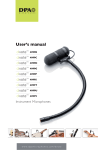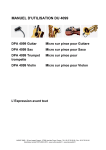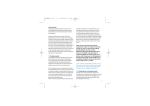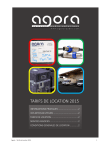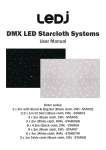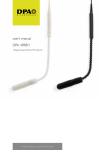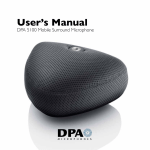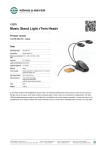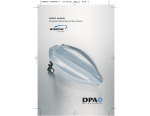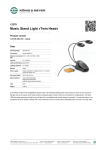Download User's ManUal
Transcript
User’s Manual 4099 Clip Microphones DPA 4099B DPA 4099C DPA 4099D DPA 4099G DPA 4099P DPA 4099S DPA 4099T DPA 4099U DPA 4099V A CONTENTS Product description. . . . . . . . . . . . . . . . . . . . . . . . . . . . . . 4099B for Bass and more. . . . . . . . . . . . . . . . . . . . . . . . . 4099C for Cello and more . . . . . . . . . . . . . . . . . . . . . . . . 4099D for Drums. . . . . . . . . . . . . . . . . . . . . . . . . . . . . . . 4099G for Guitar, Dobro, and more. . . . . . . . . . . . . . . . . 4099P Stereo Microphone System for Piano and more. . 4099S for Saxophones, Bass Clarinet, and more. . . . . . . . 4099T for Brass. . . . . . . . . . . . . . . . . . . . . . . . . . . . . . . . . 4099U Universal Clip Microphone. . . . . . . . . . . . . . . . . . . 4099V for Violin, Mandolin, and more. . . . . . . . . . . . . . . Application notes. . . . . . . . . . . . . . . . . . . . . . . . . . . . . . . . Using the DPA adapters. . . . . . . . . . . . . . . . . . . . . . . . . . . Microphone maintenance. . . . . . . . . . . . . . . . . . . . . . . . . Specifications and graphs. . . . . . . . . . . . . . . . . . . . . . . . . . Service and repair. . . . . . . . . . . . . . . . . . . . . . . . . . . . . . . Warranty. . . . . . . . . . . . . . . . . . . . . . . . . . . . . . . . . . . . . . . 2 . . . . . . . . . . . . . . . . . . . . . . 3 3 4 5 8 9 10 . 11 12 14 15 17 19 20 22 23 PRODUCT DESCRIPTION The DPA 4099 instrument clip microphone is lightweight, flexible and simple to mount, making it the perfect match for your instrument. It carries a superb natural sound quality and maximum off-axis rejection to achieve excellent gain-before-feedback characteristics for live sound reinforcement. This is the ultimate miking solution for your live instrument applications. Two different microphone sensitivities are available: • Normal sensitivity for bass, cello, guitar, piano, saxophone, violin, and universal use (marked with a black cable relief at the connector end). • Extra low sensitivity with ultra high sound pressure capability for brass and drums (marked with a white cable relief at the connector end). 4099B Clip Microphone for Bass and more Mounting the gooseneck Secure the gooseneck by sliding the fixation part over the grip: 3 Mounting the microphone Mount the 4099B on the bass by attaching it on the two outer strings between the bridge and the tailpiece. Let the holder curve inwards. Adjust the gooseneck and microphone angle to your desired taste. For the most natural sound: Below the bridge, between instrument top (belly) and strings. For the highest output: angled to one of the f-holes. 4099C Clip Microphone for Cello and more Mounting the gooseneck Secure the gooseneck by sliding the fixation part over the grip: 4 Mounting the microphone Mount the 4099C on the cello between the bridge and the tailpiece. Attach it on the two outer strings, let the holder curve outwards. Adjust the gooseneck and microphone angle to your desired taste. For the most natural sound: Below the bridge, between instrument top (belly) and strings. For the highest output: angled to one of the f-holes. 4099D Clip Microphone for Drums Mounting the gooseneck Secure the gooseneck in the holder. The gooseneck securing part can be angled 90 degrees offering maximum placement possibilities. Detach the part from the clip and re-mount it turned 90 degrees for a horizontal gooseneck arm. 5 Mounting on instrument The enclosed clip fits most drums and percussion instruments and can be mounted two ways, either upwards or downwards: Clip mounted upwards. Upward turning clip positioning allows for mic placements across the drum skin and will be the most typical live application choice for rock. Point the microphone to the middle of the drum to get more low-end richness or to the edge to get more crispy bite. Clip mounted downwards. Downward turning clip positioning allows for mic placements a little further away from the drum and will be a preferred choice for most invisible placements suitable for TV productions. Sonically, this position will also often be the choice for jazz. 6 Application note, Snare Drum A snare drum may benefit from a two-microphone setup, one on top and one below the drum; the upper mic will focus on the “in-your-face” punch and the lower mic on the snare highfrequency bite from below the drum. Shift polarity on one of them and blend them in desired balance. Application note, Bass Drum The VC4099 clip (optional accessory) also fits the bass drum rim. The bass drum, too, can benefit from a two-microphone setup, one on the stroke side and one on the front side. Shift polarity on one of them and blend them in the desired balance, controlling the “kick” sound and the low frequency component. 7 4099G Clip Microphone for Guitar, Dobro, and more Adjusting the clip height The height of the 4099G clip can easily be adjusted to fit a wide variety of stringed instruments with a body depth between 35 mm (1.4 in) and 122 mm (4.8 in).. Press the lock on the side of the clip to increase height: Place the clip in its maximum position on the instrument, and reduce the height to fit the instrument, by pressing the parts firmly together. Mounting the gooseneck Choose the desired gooseneck height and place it in the grip. Secure the gooseneck by sliding the fixation part over the grip: Mounting on instrument The 4099 can be easily readjusted and moved to different instruments by using just one hand. Squeeze the two clamp knobs on the clip to expand it, mount on the instrument, and then release. 8 It will now fit the shape of the instrument. This will vary depending on the required instrument and playing style. Application note A recommended miking placement for the most balanced sound is where the fretboard meets the body, typically above the 12th fret. For optimum volume, point the microphone toward the sound hole. A blend between your guitar’s pick-up and the 4099 condenser microphone is often a good choice on stage. This can provide even more gain before feedback while keeping a natural guitar tone. The DAO4099 Double Cable will reduce cable clutter. 4099P Stereo Microphone System for Piano and more Mounting the gooseneck in holders Secure the goosenecks in the holders by sliding the fixation part over the grip: 9 Placement of microphones Place the holders in the piano frame and adjust the microphone angle to preferred sonic taste. The microphones can be spaced apart, angled apart, or both. Specifications specific to the 4099P Sensitivity selection tolerance for pair: ± 1 dB at 1 kHz. Any 4099 microphone within this sensitivity tolerance is marked with a white dot on the gooseneck fixation part. 4099S Clip Microphone for Saxophones, Bass Clarinet, and more Mounting the gooseneck Secure the gooseneck by sliding the fixation part over the grip: Mounting on instrument The 4099S can be easily readjusted and moved to different instruments by using just one hand. Squeeze the two clamp knobs on the clip to expand it, mount on the instrument, and then release. It will now fit the shape of the instrument. This will vary depending on the required instrument and playing style. 10 Application note, soprano sax: For a round and warm character, place the 4099S as far away from the bell as possible. Place it in front of the bell for a harder sound with more bite. Application note Alto/tenor/baritone sax: To create the most balanced sound, do not point the microphone directly into the bell, but angle it between the bell and the keys. In this way you will obtain a nice blend from the two sound components of the saxophone. 4099T Clip Microphone for Brass Mounting the gooseneck Secure the gooseneck by sliding the fixation part over the grip: Mounting on instrument The 4099T can be easily readjusted and moved to different instruments by using just one hand. Squeeze the two clamp knobs on the clip to expand it, mount on the instrument, and then release. It will now fit the shape of the instrument. This will vary depending on the required instrument and playing style. 11 Adjusting the gooseneck and microphone angle The gooseneck can flex in all directions. Bend the gooseneck to fit the natural curves of the instrument. Turn the microphone to the desired angle. Application notes Ftor trumpet, trombone (and instruments of similar sizes): For the smoothest sound, do not point the microphone directly into the center of the bell, but position it between the center position and the bell’s edge. All types of mutes can be used together with the 4099. 4099U Universal Clip Microphone Mounting the gooseneck Secure the goosenecks in the holder by sliding the fixation part over the grip: 12 The gooseneck securing part can be angled 90 degrees offering maximum placement possibilities. Detach the part from the clip and re-mount it turned 90 degrees for a horizontal gooseneck arm. Application note Close-miking instruments like oboe, clarinet, soprano saxophone, and bassoon calls for certain care in the placement and angling of the microphone. The 4099 holds a supercardioid directionality and may end up creating an uneven timbre. Tip: Create as much distance as possible with the gooseneck and place the mic head above the bell. Twist it backwards to the instrument and point it towards the upper joint (the keys closest to the mouthpiece). In this way the entire instrument range will be covered most naturally. Place the hook-and-loop fastener around the instrument and insert the end into the opening below the gooseneck. Tight firmly if necessary by pushing the holder at the same time. 13 4099V Clip Microphone for Violin, Mandolin, and more Adjusting the clip height The height of the VC4099 Violin Clip can easily be adjusted to fit a wide variety of stringed instruments with a body depth between 35 mm (1.4 in) and 55 mm (2.1 in).. Press the lock on the side of the clip to increase height. Adjusting the gooseneck and microphone angle The gooseneck can flex in all directions. Bend the gooseneck to fit the natural curves of the instrument. Turn the microphone to the desired angle. Application note Most players prefer the 4099 to be placed on the left side of the instrument to avoid restricting the player’s movement. Point the microphone away from the performer’s head to avoid breath noise. For optimum volume, point the microphone toward the f-hole. Please note that this also makes the sound character a little duller, which may or may not suit your taste. If not, point the microphone at the bridge. 14 GENERAL APPLICATION NOTES • Always use the 4099 in its dedicated foam windscreen and shock absorbing rubber mounts. • When running wireless, it is recommended to use a low-cut filter at 80 Hz in the transmitter to avoid handling and moving noise. This low-cut filter is built into the DAD4099 XLR adapter supplied with 4099G, 4099V 4099S, and 4099T. • The optional DMM0007 Universal Surface Mounts can be useful to control the cable run along the instrument. Tip: The same gooseneck microphone boom can be used with alternate clips that are specific to each instrument. Bear in mind the difference in mic sensitivity according to different instruments’ sound pressure levels – see page 3. 15 16 BC4099 Clip for Bass and more CC4099 Clip for Cello and more DC4099 Clip for Drum GC4099 Guitar Clip PC4099 Magnet Mount for Piano and more STC4099 Sax/Trumpet Clip UC4099 Universal Clip VC4099 Violin Clip USING THE DPA ADAPTERS All DPA 4099 clip microphone cables are terminated with a proprietary MicroDot connector. When used in conjunction with our range of over 35 adapters, the MicroDot connector provides the ability to connect to virtually all available pro wireless systems. Various wireless systems require the use of electronics inside the adapter to optimize the signal level, the DC offset, and powering of the built-in microphone preamplifier. Using the adapters from DPA ensures the correct electronic circuit with the listed types of wireless systems (please visit www.dpamicrophones.com/ adapters). The enclosed XLR adapter allows the 4099 to work as a regular 48V phantom powered microphone. The belt clip can be removed and replaced with the enclosed ring for use of the adapter directly in stage boxes or mixing consoles. Dismount the cap of the adapter, remove the belt clip and place the black ring instead. Remount the cap. Do not attempt to employ non-standard adapters or connectors as you might damage the microphone. A connector-tightening tool is supplied with each adapter and should be employed whenever the MicroDot connector needs to be tightened. Utilize the tightening tool before use to ensure the connection is secure and that the cable cannot rotate by the cable relief. Enclosed adapter DAD6001-BC DPA 4099B DPA 4099C DPA 4099D DPA 4099P DPA 4099U DAD4099 DPA 4099G DPA 4099S DPA 4099T DPA 4099V 17 The DAD4099 adapter features a permanent second-order low-cut filter at 80 Hz. The filter minimizes handling and wind noise at the microphone output without compromising sound quality, as guitar, sax, trumpet and violin have no appreciable frequency response below 80 Hz. Signal - phase 3 Signal + phase Ground 2 1 External view of the output connector of the DAD4099 and DAD6001-BC. 18 MICROPHONE MAINTENANCE DPA 4099 is designed with highly resistant and protective materials in the construction so do not try to clean the microphone as it is unnecessary. Do not use any spray or fluid containing chemicals that could remove static electricity on or close to the microphone. This could cause permanent damage. Should the foam windscreen need replacement, remove it from the microphone. Draw the windscreen, not the microphone, away from the shock mount, while holding the microphone cable. Cleaning or washing of the windscreen can be done in distilled water. For cable cleaning; Use organic oil (e.g. olive oil) or lukewarm, distilled water to remove residue from tape or glue. The DPA 4099 is very resistant to humidity and sweat, but keep it away from unnecessary exposure to water and cleaning fluids (keep element dry at all times). It should not be used in direct, heavy rain. Avoid excessive pressure on the microphone element. The microphone will not perform to its specifications if the directional tube under the foam windscreen has been bent from its original shape. If the directional tube becomes misshapen, it should be reshaped as close as possible to its original cylindrical shape. To minimize potential cable damage, wind up excess cable in soft figure-of-eight loops (preferably 6 – 8 cm (2.5 – 3 in) in diameter), this also helps to reduce handling noise. Do not bend the cable or rub it harshly, that may stress the inner cores and cause them to break over time. 19 Directional characteristics Supercardioid Principle of operation Pressure gradient Cartridge type Pre-polarized condenser Frequency range 20 Hz - 20 kHz Frequency range, ± 2 dB, 20 cm (7.9 in) distance 80 Hz - 15 kHz with 2 dB soft boost at 10 - 12 kHz Second order low-cut filter at 80 Hz with DAD4099 Sensitivity, nominal ± 3 dB at 1 kHz 4099B/4099C/4099G/4099P/4099S/4099U/4099V: 6 mV/Pa; - 44 dB re. 1 V/Pa 4099D/4099T: 2 mV/Pa; -54 dB re. 1 V/Pa Equivalent noise level, A-weighted 4099B/4099C/4099G/4099P/4099S/4099U/4099V: Typ. 23 dB(A) re. 20 µPa (max. 26 dB(A)) 4099D/4099T: Typ. 28 dB(A) re. 20 µPa (max. 31 dB(A)) S/N ratio (A-weighted), re. 1 kHz at 1 Pa (94 dB SPL) 4099B/4099C/4099G/4099P/4099S/4099U/4099V: 71 dB 4099D/4099T: 66 dB Total Harmonic Distortion (THD) < 1 % up to 123 dB SPL peak < 1 % up to 120 dB SPL RMS sine Dynamic range 4099B/4099C/4099G/4099P/4099S/4099U/4099V: 100 dB 4099D/4099T: 95 dB Max. SPL, peak before clipping 4099B/4099C/4099G/4099P/4099S/4099U/4099V: 142 dB 4099D/4099T: 152 dB Output impedance From MicroDot: 30 – 40 ohm From DAD4099/DAD6001-BC: 100 ohm Cable drive capability Up to 300 m (984 ft) with DAD4099 or DAD6001-BC XLR adapter Output balance principle Signal balanced with DAD4099 or DAD6001-BC XLR adapter Common Mode Rejection Ratio (CMRR) > 60 dB from 50 Hz to 15 kHz with DAD4099 or DAD6001-BC XLR adapter 20 Power supply Min. 5 V – max. 50 V through DPA adapter for wireless systems 48 V phantom power ±4 V with DAD4099 or DAD6001-BC XLR adapter XLR adapter Current consumption Typ. 1.5 mA (microphone) 3.5 mA with DAD4099 or DAD6001-BC XLR adapter Connector MicroDot Color Black Weight 4099B: 46 g (1.62 oz) 4099C: 38 g (1.34 oz) 4099D: 38 g (1.34 oz) 4099G: 36 g (1.27 oz) 4099P: 46 g (1.62 oz) 4099S: 31 g (1.1 oz) 4099T: 31 g (1.1 oz) 4099U: 41 g (1.4 oz) 4099V: 33 g (1.16 oz) Capsule diameter 5.4 mm (0.2 in) 5 dB 16 kHz 1 kHz 2 kHz 250 Hz 500 Hz 8 kHz 4 kHz Polar Pattern Directional characteristics of DPA 4099 (normalized) 21 10 dB 0 0˚ 30˚ 180˚ -10 60˚ -20 20 Hz 90˚ 50 100 200 500 1 kHz 2 5 10 20 40 1 kHz 2 5 10 20 40 On-Axis Frequency Response Measured at 20 cm (7.9 in) distance 10 10 cm dB 15 cm 0 20 cm 30 cm -10 100 cm -20 20 Hz 50 100 200 500 The Proximity Effect The proximity effect exhibited by DPA 4099 SERVICE & REPAIR Products from DPA Microphones are extremely stable and there should not be any significant change in the specifications with time and use. If, however, you are not satisfied with the characteristics exhibited by your product, contact your nearest DPA Microphones representative for further details of service and the repair facilities that are available. 22 10 dB 0 -10 DAD4099 -20 20 Hz 50 100 200 500 1 kHz 2 5 10 20 40 On-Axis Frequency Response with DAD4099 XLR Adapter Measured at 20 cm (7.9 in) distance 10 dB 0 -10 -20 20 Hz 50 100 200 500 1 kHz 2 5 10 20 40 On-Axis Frequency Response with DAD4099 XLR Adapter Measured at 10 cm (3.9 in) distance WARRANTY All products from DPA Microphones are covered by a two-year limited warranty on both mechanical functionality and documented specifications as long as the items are not mistreated, abused, or modified in any way. In case of a warranty claim, your invoice is your warranty registration. Find your nearest DPA representative on our website, www.dpamicrophones.com, or send e-mail to [email protected]. 23 DPI4099- 4 DPI4099-3 Headquarters DPA Microphones A/S Gydevang 42-44 DK-3450 Alleroed, Denmark Tel: +45 4814 2828 Fax: +45 4814 2700 [email protected] www.dpamicrophones.com US Sales Office DPA Microphones, Inc. 2432 N. Main St., Suite 200 Longmont, CO 80501, USA Tel: +1 303-485-1025 Fax: +1 303-485-6470 [email protected] www.dpamicrophones.com
























